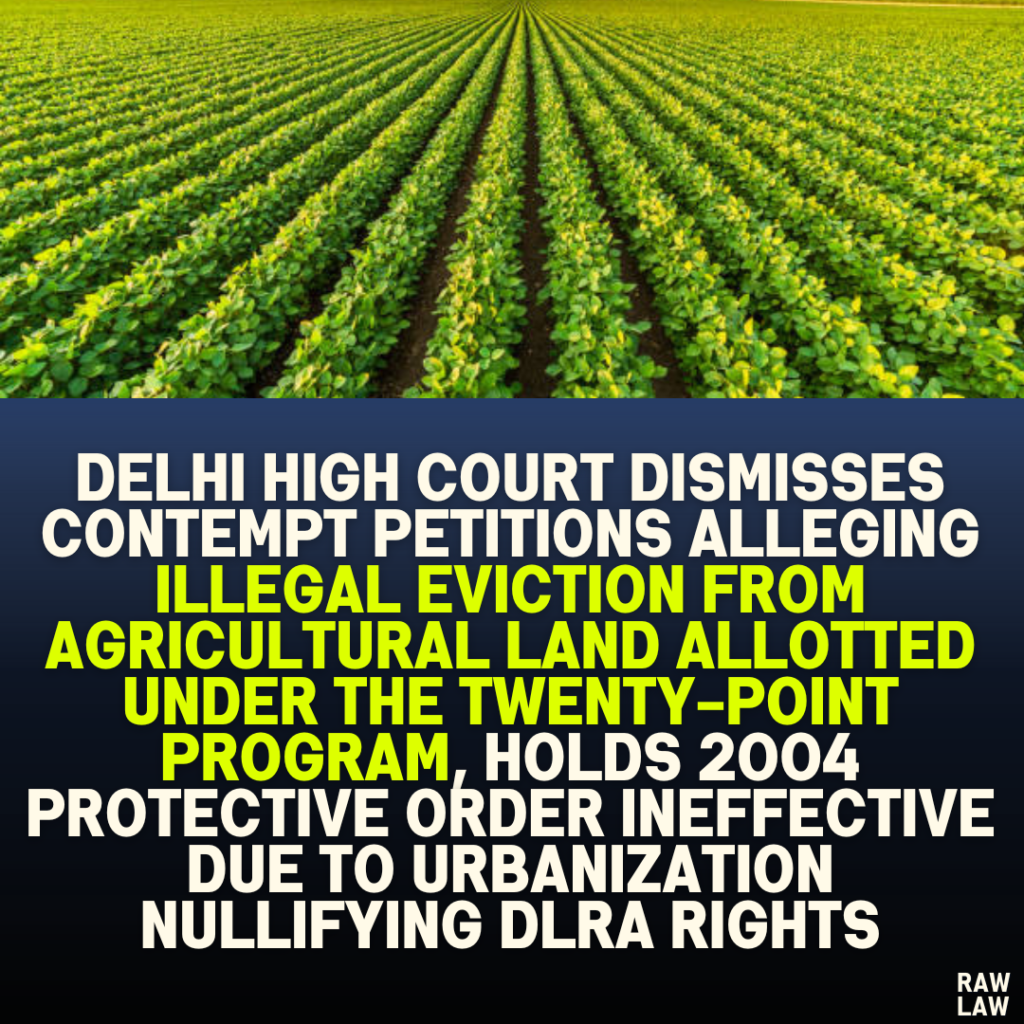Court’s Decision: The Delhi High Court dismissed the two contempt petitions, concluding that the 2004 interim order restraining eviction was no longer binding. This decision was based on the fact that the land in question, located in Village Nasirpur, had been notified as urban under Section 507 of the Delhi Municipal Corporation (DMC) Act, making proceedings under the Delhi Land Reforms Act (DLRA) non-applicable. The court found that the petitioner’s claim to possession became legally insignificant due to this urbanization.
Facts: The petitioners’ predecessors, belonging to reserved categories, were allotted agricultural land in 1974 under the Government’s Twenty-Point Program. Over time, they invested efforts to reclaim and cultivate the barren land despite challenges. However, in 2005, their application for bhoomidari rights was rejected, prompting appeals up to the Financial Commissioner. Subsequently, in 2004, the High Court issued an order protecting their possession until these proceedings concluded.
The controversy arose when, in 2021, officials allegedly forcibly removed the petitioners from the land using heavy equipment and police force, despite the 2004 High Court order. The respondents argued that the land had been vested in the Delhi Development Authority (DDA) and later allotted to the Department of Education (DoE) for a school project.
Issues:
- Whether the petitioners’ eviction violated the 2004 High Court order protecting their possession.
- Whether the urbanization of Village Nasirpur nullified the application of DLRA and, consequently, the petitioners’ possession rights.
Petitioner’s Arguments: The petitioners argued that the eviction violated the 2004 High Court order protecting their possession. They contended that the respondents acted unlawfully by disregarding this order, which they claimed was still in effect due to the pending proceedings before the Financial Commissioner. The petitioners sought reinstatement of possession, alleging that the DDA’s transfer of the land to the DoE was illegitimate.
Respondent’s Arguments: The respondents argued that the land had been vested with the DDA and subsequently transferred to the DoE, which legally took possession in 2007 for a school project. They highlighted the urbanization of Village Nasirpur in 1994, which excluded it from DLRA’s jurisdiction. Respondents contended that the interim order became ineffective upon the urbanization notification, rendering the petitioners’ possession claims void.
Analysis of the Law: The court considered provisions of the DMC Act, specifically Section 507, which deems rural areas under the DLRA as urbanized. The court referenced Supreme Court precedent holding that DLRA’s applicability ends once an area is urbanized, nullifying any rights or protections that would apply under it. The urbanization of Village Nasirpur in 1994 legally removed the petitioners’ claim to DLRA protections, rendering the interim order non-binding.
Precedent Analysis: The court referred to the Supreme Court case Mohinder Singh (dead) through LRs v. Narain Singh, which clarified that DLRA rights cease upon an area’s urbanization under the DMC Act. It reaffirmed that proceedings under DLRA in urbanized areas are legally void, emphasizing that petitioners could not claim any entitlement under DLRA after urbanization.
Court’s Reasoning: The court found that the urbanization notification had dissolved the Gaon Sabha’s authority over the land, eliminating DLRA’s applicability. The interim order was based on pending bhoomidari rights, which, according to the court, became irrelevant under the DMC Act. Thus, the 2004 order protecting possession was rendered ineffective by law, invalidating the petitioners’ claim.
Conclusion: The court concluded that the contempt petitions lacked merit because the 2004 protective order was legally nullified by the urbanization of Village Nasirpur. As a result, any claims to possession by the petitioners could not be enforced under DLRA.
Implications: This judgment underscores that urbanization notifications under the DMC Act extinguish rural land rights under DLRA. It reinforces that protections granted in pending proceedings under DLRA are rendered void if the land is urbanized. The case clarifies that interim orders contingent on DLRA proceedings do not survive the urbanization of the area, which can impact other pending cases involving rural-urban jurisdictional transitions.




Pingback: Bombay High Court Orders Disclosure of Candidate Marks, Emphasizes "Transparency and Accountability in Public Recruitment to Prevent Unjustified Doubts About the Process" - Raw Law